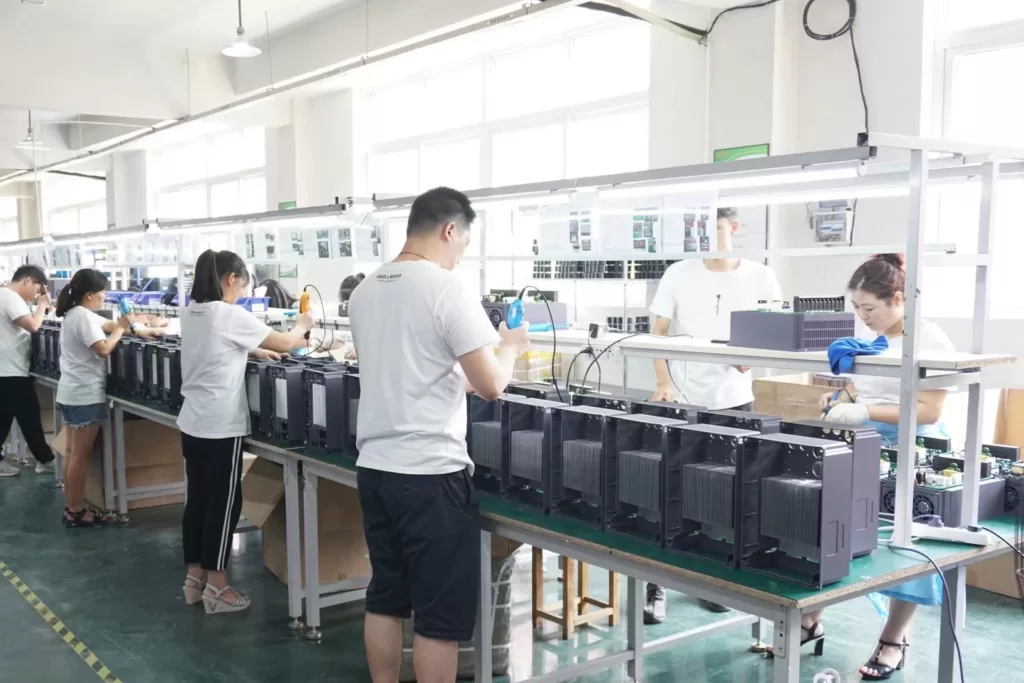As industrial automation and smart technologies advance, motor inverters are playing an increasingly significant role in machinery. These devices, key for motor control, are known for their energy efficiency, high performance, and precision. This article will delve into the basics of motor variable frequency drives (VFDs), their classifications, applications, and how to choose the right one for your needs.
1. What Are the Basic Principles Behind Motor Inverters?
The core function of an inverter is to modify the frequency of AC power supplied to a motor. First, the AC power is converted into DC through rectification, after which the current is smoothed. This DC power is then inverted back into AC with the appropriate frequency and voltage, giving the motor the desired speed. The entire process, from rectification to inversion, allows for precise control over the motor’s operations.
When it comes to controlling the motor, inverters offer several methods. For instance, V/F control adjusts the voltage-to-frequency ratio to manage speed. While it’s a simple and economical option, it’s not the most precise. Alternatively, Vector control (FOC) breaks down the motor’s current into components for better speed and torque regulation, making it ideal for high-performance systems. Lastly, Direct Torque Control (DTC) is used when fast response is crucial, and sensorless control provides a lower-cost option by eliminating the need for physical sensors.

2. How Are Motor Inverters Classified?
Motor inverters come in different types, each suited to specific applications. General-purpose VFDs are versatile and work with various machines like pumps, fans, and conveyors. On the other hand, specialized models are designed for particular industries. For example, textile machinery may require a VFD with tension control, while elevators need frequency drives that ensure smooth starts and stops.
High-performance inverters, often used in CNC machines and robotics, are equipped with advanced control methods like vector control, offering precise regulation of motor speed and torque. In contrast, micro inverters, although compact and lightweight, are ideal for smaller machinery with limited space but still offer basic speed adjustment features.
3. Where Are Motor Inverters Applied?
From factory floors to transportation systems, motor frequency converters are everywhere. In industrial automation, for instance, these devices are essential in optimizing the performance of equipment like fans, water pumps, and injection molding machines. By regulating motor speed and torque, they ensure energy efficiency and operational precision.
But that’s not all—buildings and infrastructure also rely heavily on inverters. HVAC systems, elevators, and water supply mechanisms all use them to maintain stability and reduce energy consumption. In transportation, they are found in electric vehicles, trains, and ships, where they help improve efficiency and ensure safety. Even agriculture benefits from frequency converters, especially in modern irrigation systems, wind energy production, and biomass equipment.
4. What Should You Consider When Choosing a Motor Inverter?

When selecting the right variable frequency drive for your equipment, it’s essential to factor in power and voltage requirements. The inverter must match the motor’s rated specifications to ensure optimal performance. Equally important is the choice of control method: for simple applications, V/F control may suffice, while more dynamic, high-precision operations benefit from vector control or DTC.
The operating environment is another critical aspect. Inverters designed for industrial settings must be able to withstand specific conditions such as high temperatures, humidity, or dust. Finally, consider the functionality and expandability of the device. Ensure the inverter supports the necessary features, such as multi-speed control or communication interfaces, and opt for a brand with a reliable track record for after-sales support.
5. Conclusion
Motor inverters are indispensable across many industries—from industrial automation to building infrastructure and agriculture. Their ability to efficiently manage motor control makes them essential tools for ensuring energy savings and high performance in machinery. By understanding the basic principles, different types, and selection criteria, you can make informed decisions when choosing a frequency converter that fits your specific needs.
